

Trekking in Photogenic Taimushan (太 姥 山)
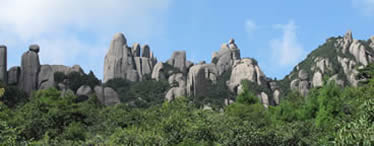 |
TREKKING IN PHOTOGENIC TAIMUSHAN Taimushan is located near the sea and at the boundary between Fujian & Zhejiang provinces. It is renowned for its photogenic landscapes and is one of China’s Geoparks.
|
(A) Introdution
Taimushan is located near Fuding city which is at the boundary between Fujian and Zhejiang provinces. It is about 200km from Fuzhou city and is quite close to the sea. Taimushan, with many majestic granite peaks, grotesque stone pillars, extraordinary caves and rock crevices, is renowned for its magnificent photogenic landscapes. The whole scenic spot of Taimushan covers an area of 86 sq. km.

Taimushan was approved to be one of China’s National Geoparks in 2004 by the Ministry of Land & Resources, PRC. It has yet to be included into UNESCO’s Global Geopark Network.
A Geopark is defined by UNESCO as “A territory encompassing one or more sites of scientific importance, not only for geological reasons but also by virtue of its archaeological, ecological or cultural value”.
(B) Journey to Taimushan
According to our itinerary, we were to leave for Xiamen and take a train to Fuzhou and Fuding after we completed our exploration of Hakka Tulou on the 09 Sept (Thursday). We left Taxia Village in Nanjing Province early in the morning on 10 Sept to Xiamen train station. From there we would take a train to Fuzhou and then a connecting train from Fuzhou to Fuding where Taimushan is situated. Upon arrival in Xiamen at about 10am, we went to the travel agent’s office to collect our train tickets and then we proceeded to Xiamen train station. The train to Fuzhou was to depart at 11.10am. At the departure section there was a massive jam with a lot of passengers shouting, pushing and shoving to gain entry into the train’s departure lounge.

It was 10.30am when Jenny, with the train tickets, was leading us to the entry gate and adopting the deplorable attitude of the locals we finally reached the entry gate guarded by a lady. She was shouting hoarsely at Jenny when our train tickets were shown to her. In Chinese she shouted “Go and redeem the tickets – train cancelled!” When asked why, she shouted, “Typhoon!” We noticed that she behaved the same to all who approached her.
We got out of the mess and saw not a single sign or notice anywhere to inform passengers about the cancellation of train services and the typhoon. Jenny called the travel agent in the city to get more information and to seek advice. The travel agent told Jenny that the office had no information about the fiasco, but would find out and revert to her. After about 15 minutes, Jenny was informed that all train services to Fuzhou that day were cancelled because the National Meteorological Centre had given warning that Typhoon Meranti, which had hit the coaster area of Quanzhou earlier in the morning, would bring strong wind and torrential rain to parts of southern China. But there was no information on the resumption of train services.
We decided to go the travel agent’s office to wait for further information. The driver, Xiao Gao, came to the train station to take us to the office in the city. While waiting in the office I decided that if the bad situation were to prolong, it would be better to return home. I called my air-ticket agent in KL, Lena, and asked her whether any seats in MAS flight to KL were available the next day i.e. 11 Sept (Saturday). Either way it was inevitable that we had to have an overnight stay in Xiamen and to wait for news whether we could resume our journey in Fujian or return home the next day.
We had a sumptuous lunch at a new restaurant in the city with Mr Zheng and all his staff. As usual in China, the host must not “kia-su” when giving a treat to his guests: we had ten huge dishes for a table of ten diners!
After the heavy lunch we were transferred to a hotel in the city. Resting in the hotel, I received a SMS from Lena informing me that no seats were available on flight to KL the next day. In the evening, Jenny was informed by the travel agent that our old train tickets were exchanged for new ones to travel to Fuzhou tomorrow at 12 noon. But there was no news about the train services from Fuzhou to Fuding on the same day. If there was no connecting train to Fuding, we had to stay a night in Fuzhou and take a train to Wuyishan the next day i.e. 12 Sept (Sunday). If that was the case we would not have the time to visit Taimushan!
As luck would have it, while we were on a cruise in Xiamen to see Gulangyu in the morning Jenny was informed that the connecting train services from Suzhou to Fuding were available and so we could visit Taimushan tomorrow morning (12 Sept) and then take a train to Wuyishan in the afternoon. That was a pleasant piece of news and our remaining travel schedule was finally resolved.
(C) Nuilanggang ( 牛 郎 港 ) & Taimushan
We took the Xiamen to Fuzhou high speed train at 12 noon on Saturday, 11 Sept. We arrived at Suzhou at 2pm. And from Suzhou we took the connecting train to Fuding and arrived there at 4pm. Along the journey by train, the weather was fine and when we arrived at Fuding the sun was bright and shining. As it was still early we decided to visit Nuilanggang, a bay not too far away from Fuding town. We reached the beach within half an hour and had relaxing rest in a beach which was not too crowded at this time of the day. We left after an hour on the beach and put up in Qin Yu Town (秦 峿 镇), not too far away from Taimushan.
 |
|
Beach at Nuilanggang
(D) Trekking in Taimushan
As we had to catch a train from Fuding to Suzhou by noon and from there to Wuyishan, we left early from the hotel to Taimushan and had our packed breakfast in the car. We arrived at the entrance to Taimushan at 7am and started our trek. There are many tracks within the park to choose from depending on the time available, physical fitness and bodily physique (slim or fat). As we had to be at the Fuzhou train station by noon, we could afford to spend 3.5 hours in the park. As four of us are slim, our guide, Ms Jiang chose tracks with stiffer gradients, more scenic spots and through dark caves and narrow rock crevices.
 |
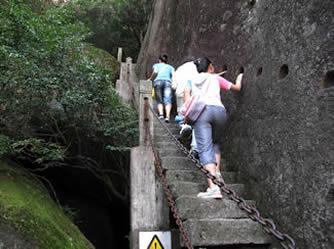 |
Easy Tracks
 |
 |
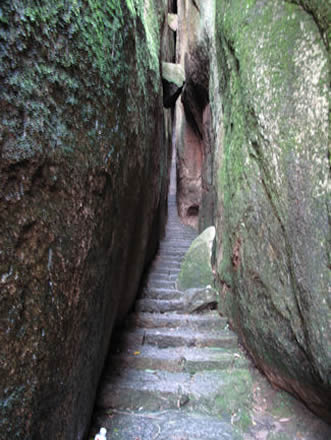 |
 |
Walking Through Caves & Narrow Crevices
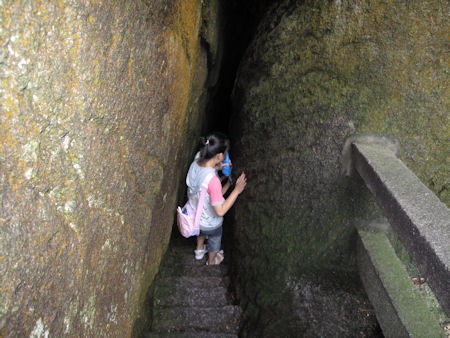
Rock Crevices
These are linear type of fractures which are narrow and dark inside. A man can hardly get through the crevice with the body facing forwards. To get through some tight crevices, sometime one has to bend, squat, squeeze or walk sideways.
(F) Scenic Spots in Taimushan
The park consists of many figurative stones which are created by weathering. There are named according to their formation and shapes, like “Husband and Wife”, “Taimu Goddess”, “Heavenly Column”, etc.

Nine Carps Facing Sky
This is the most glorious peak cluster landscape in Tamushan. The cluster with various shapes and sizes of peaks stretches about 1km long and up to 100m high.

Husband and wife
The Husband and Wife Peak looks like a couple in harmony. According to legend, a young couple living in the fishing village at the foothill of Taimushan happened to be parted and became a monk and a nun. Later they met again, but unfortunately they were transformed magically into two stones.

Golden Turtle
The stone turtle, located behind Yipianwa Temple, tries to climb upwards to reach the top but failed. The Legend says that the Golden Turtle was originally a monk trying to follow the Taimu Goddess. When the Taimu Goddess was ascending to Heaven, the Turtle could not follow but still keeps on climbing.

Heavenly Peak
The Heavenly Peak is 40m high. It was sculptured by running water that eroded the granite along the fractures. There is a cat and mice on top of Heavenly Peak. These were formed when the granite had been weathered and eroded leaving the remains on top which resemble a cat and many mice.
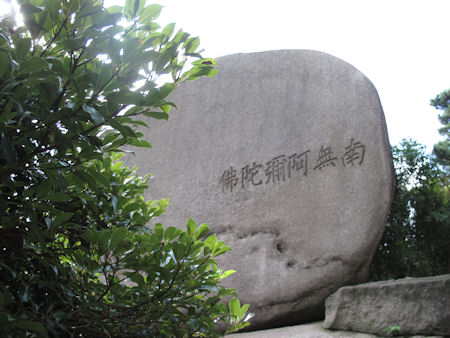
Screen Stone
The huge piece of stone, 5m wide and 4m high, looks like a large TV screen with a remote control (a small rectangular block) in front of it. It looks like the stone (TV) is broadcasting the current prices of stocks. The small cavities near the bottom are arranged in pattern resembling the current trends of the stock market.

Stone Panels Peak
This stone pillar is about 10m high and apparently was “sawn’ into three pieces. Due to water erosion, the two vertical fractures have become more pronounced. ????????.
Other Scenic Spots
 |
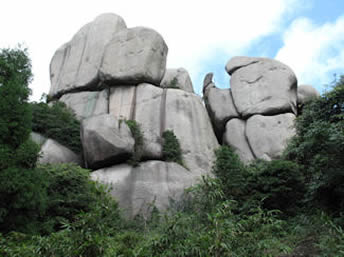 |
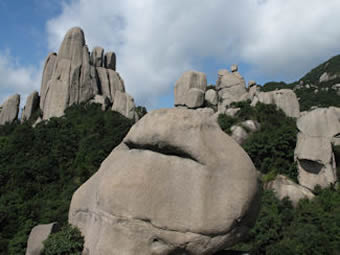 |
 |
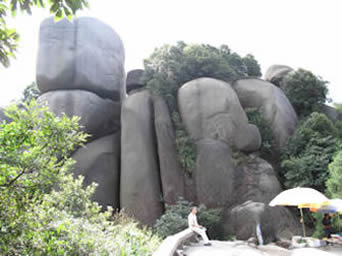 |
 |
End / Back to Home pg
